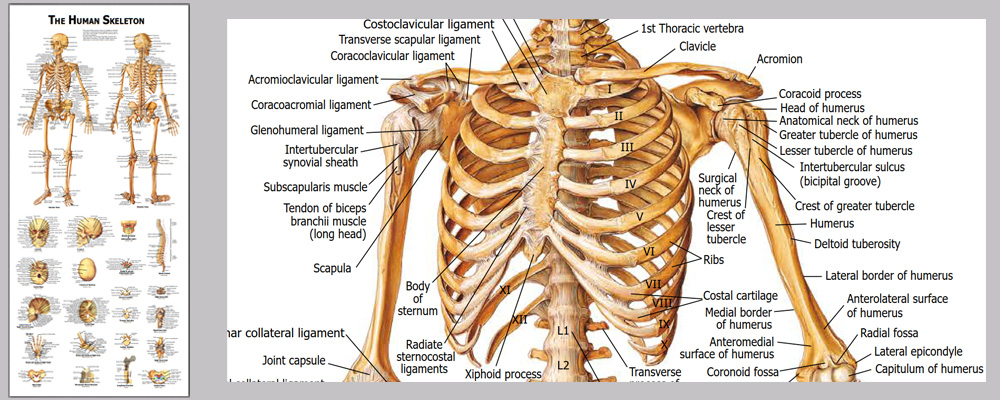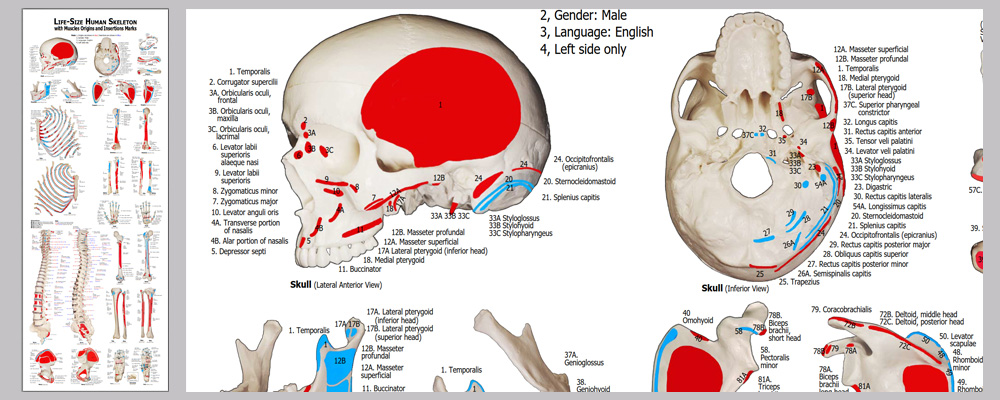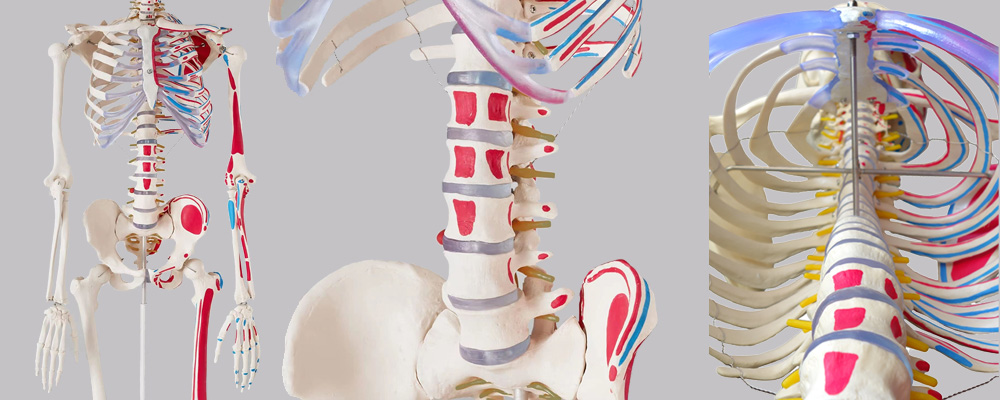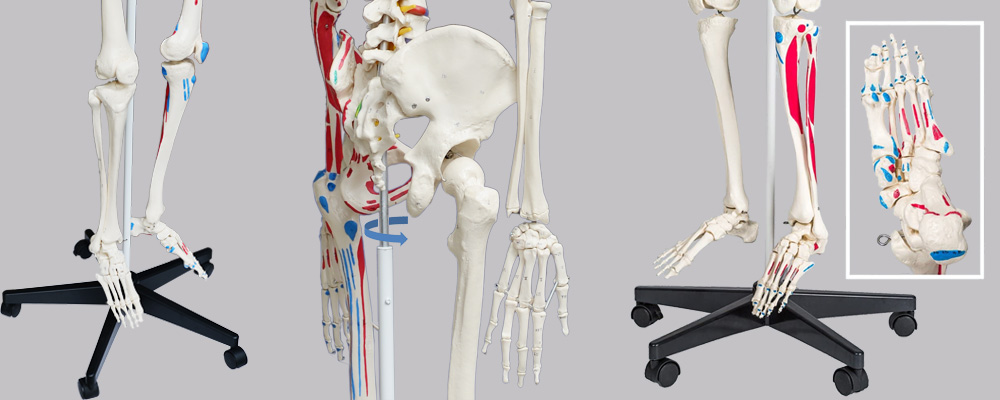human skeleton anatomical model
This life size articulated adult human skeleton model is 180cm tall & ideal for teaching / learning the basics of human anatomy. Includes a colorful Human Skeleton chart to show all the detailed structures for reference.Detailed colorful chart with over 630 accurate definitions. Durable and no reflection with matte film covered, 36 * 78cm

Detailed muscles origins and insertions with codes. Durable and no reflection with matte film covered, 100cm * 38cm

Stainless steel wires keep the ribs gaps stable.

2 of 5 casters are lockable.

With JC anatomy, you can also demonstrate the movements of the skull via the head joints, and thanks to the fully flexible spine, you can adjust the human skeleton anatomical model to place it in natural body postures. The unique combination of muscle origins and insertions, the numbered bones, flexible ligaments and flexible spine with a slipped disc between the 3rd and 4th lumbar vertebrae clearly the show medical and anatomical interest of this top model's more than 645 structures. Now available on a stable metal stand with 5 casters!
| Product name | human skeleton anatomical model |
| Place of Origin | Shenzhen China |
| Product Material | PVC, ABS, SST |
| Rib cage | A 5mm dia |
| Human skeleton model life | 20years |
| Surface treatment | Polish. Etched. Texture |
| SUPPORT 24/7 | Contact us 24 hours a day, 7 days a week |
| Size | 84 * 73 * 125 |
| Port | Shenzhen |
| PAYMENT & ORDERING | PayPal account or pay by credit card |
human skeleton anatomical model FAQs Guide Are you looking for a quick review guide about human skeleton anatomical model? An ultimate FAQs buying guide is available to help you.This guide contains all the information about all the important facts, figures, and various processes regarding human skeleton anatomical model. Let’s continue!
2.How many thoracic and lumbar vertebrae are there in the human skeleton anatomical model?
3.Can the human skeleton anatomical model display many different body poses?
4.How much does it weigh and is it easy to carry and maneuver human skeleton anatomical model?
5.About human skeleton anatomical model production equipment
6.Does the human skeleton anatomical model have movable joints that can show the range of motion of various parts of the human body?
7.human skeleton anatomical model Can it be used as a teaching aid?
8.About the scale of human skeleton anatomical model factory
9.About human skeleton anatomical model delivery date
10.human skeleton anatomical model Are accompanying labels provided indicating the name and location of each bone?
11.Can bone diseases such as osteoporosis be displayed on the human skeleton anatomical model?
12.About human skeleton anatomical model origin
13.How durable is human skeleton anatomical model?
14.What kind of material is used to make the human skeleton anatomical model?
1.About human skeleton anatomical model payment method
TT, or Paypal
2.How many thoracic and lumbar vertebrae are there in the human skeleton anatomical model?
There are 12 segments in the thoracic vertebrae, 5 segments in the lumbar vertebraeGenerally, there are 12 thoracic vertebrae and 5 lumbar vertebrae in the human skeleton model. The thoracic vertebrae are located in the middle region of the spine, between the cervical vertebrae (neck) and lumbar vertebrae (lower back). They are numbered from T1 to T12, with T1 being the first thoracic vertebra closest to the skull and T12 being the last thoracic vertebra closest to the pelvis. The lumbar vertebrae are located in the lower back region, below the thoracic vertebrae. They are numbered from L1 to L5, with L1 being the first lumbar vertebra closest to the thoracic vertebrae and L5 being the last lumbar vertebra closest to the sacrum (a triangular bone at the base of the spine). However, the specific number of thoracic and lumbar vertebrae may vary slightly from person to person due to individual differences in bone structure. Some people may have 11 or 13 thoracic vertebrae, and 4 or 6 lumbar vertebrae. This is known as a variation or anomaly in the number of vertebrae. .
3.Can the human skeleton anatomical model display many different body poses?
The Human skeleton model can display many different body poses in order to show the movement and positioning of bones and muscles. The model can be manipulated into a range of poses such as the classical anatomical position, where the arms are down by the sides, palms facing forward, and feet shoulder-width apart. It can also be posed to demonstrate actions such as walking, running, jumping, and sitting. The flexibility of the model allows for a wide range of movements to be shown, from simple movements of individual joints to complex combinations of actions involving multiple joints. Additionally, the model can display different body poses by adjusting the positions of individual bones and joints. For example, the arms can be raised or lowered, the elbows bent or straightened, and the fingers spread or closed. The legs can be straightened or bent at the knee, and the ankles can be rotated to show different directions of movement. These adjustments allow for a variety of poses to be demonstrated, from relaxed positions to more dynamic and active positions. In summary, the Human skeleton model can display a wide variety of body poses and movements, ranging from simple to complex, to showcase the functions and interactions of the bones and muscles in the human body.
4.How much does it weigh and is it easy to carry and maneuver human skeleton anatomical model?
The Net weight is 8.8kgs (19.4lbs). It's easy to move with the 5 castors
5.About human skeleton anatomical model production equipment
The production of a human skeleton model requires a variety of specialized equipment to ensure accuracy, durability, and detail in the final product. we around 50 sets dedicated equipment
6.Does the human skeleton anatomical model have movable joints that can show the range of motion of various parts of the human body?
Yes, the human skeleton model typically has movable joints that can show the range of motion of various parts of the human body. These joints are usually represented by different types of articulations such as ball and socket, hinge, saddle, pivot, and gliding joints, which mimic the movement of the actual joints in the human body. For example, the shoulder joint of a human skeleton model will have a ball and socket structure that allows for a wide range of motion, similar to the shoulder joint in a real human body. This joint is able to rotate 360 degrees and can also move forward, backward, and sideways. Similarly, the elbow joint in a human skeleton model will have a hinge structure that allows for flexion and extension movements, just like the elbow joint in a real human body. This enables the model to accurately demonstrate movements such as bending and straightening of the arm.
7.human skeleton anatomical model Can it be used as a teaching aid?
Yes, a human skeleton model is a commonly used teaching aid in various academic fields such as anatomy, biology, and medical education. It is an accurate and detailed representation of the human skeleton, providing a visual aid for students to understand and grasp the complexities of the skeletal system.
8.About the scale of human skeleton anatomical model factory
Covering an area of about 2000 m². This would include manufacturing space for assembly, molding, and finishing processes, as well as storage space for raw materials and finished products.
9.About human skeleton anatomical model delivery date
Around 40 days. Depends on qty.
10.human skeleton anatomical model Are accompanying labels provided indicating the name and location of each bone?
The stardard model does not provide this function. The chart shipped with pro model shows the name and location of each bone
11.Can bone diseases such as osteoporosis be displayed on the human skeleton anatomical model?
Yes, bone diseases like osteoporosis can be displayed on a human skeleton model. A human skeleton model is a representation of the bones and joints of the human body and can be used to educate and train students and medical professionals. Osteoporosis is a bone disease that results in weakened and porous bones, increasing the risk of fractures. As a result, there are certain features and changes in the bone structure that can be seen on a human skeleton model.
12.About human skeleton anatomical model origin
Made in China
13.How durable is human skeleton anatomical model?
The durability of a human skeleton model can vary depending on the materials used and the quality of construction. However, generally speaking, a high-quality skeleton model can be quite durable and can last for many years if properly cared for. Here are some factors that can affect the durability of a human skeleton model: 1. Materials: The most common materials used for human skeleton models are plastic, resin, and wood. Plastic and resin models are generally more durable as they are less prone to damage from impacts or moisture. Wood models can also be quite durable, but they may be more susceptible to wear and tear over time. 2. Maintenance: Proper maintenance and care can significantly increase the durability of a human skeleton model. Regular cleaning with a soft cloth and mild detergent can help keep the model free of dust and dirt. Additionally, storing the model in a protective case or covering can also help prevent damage. Overall, a high-quality human skeleton model can be quite durable and can last for many years with proper care. However, it is important to keep in mind that no model is completely indestructible, and regular wear and tear can occur over time.
14.What kind of material is used to make the human skeleton anatomical model?
The human skeleton model is typically made out of a combination of materials, depending on the specific model and its intended use. Generally, the main materials used are plastic, metal, and sometimes, natural materials such as wood. Plastic: The majority of the skeleton model is made from a high-quality, durable plastic such as polyvinyl chloride (PVC) or polyethylene. These materials are lightweight and easy to mold into the intricate and specific shapes required for each bone in the skeleton. They are also easy to paint and can be colored to resemble real bones.




